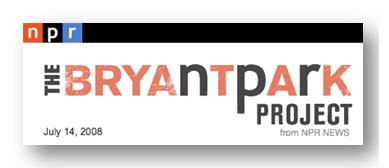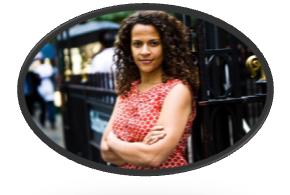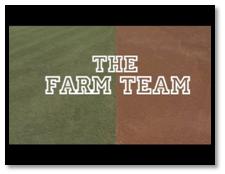Public radio fan, Paul Jacobs, takes a look at program development at NPR and how it differs from traditional efforts. Thanks to Larry Rosin for bringing the story to his attention.
In the decade just concluded, we were fortunate to work closely with NPR on their overall strategy, programming, digital, and revenue development. I don’t have to tell you how enjoyable and stimulating that relationship was – we were working with some of the best, smartest, most dedicated people in broadcasting, who cared less about what brand of car they drove (usually a Honda or used Volvo) and more about journalism and public service.
Part of our job was to help develop new programs for NPR. The process usually followed a traditional path – brainstorming, research, testing, tweaking, and then shipping it off to affiliates. One of the challenges was creating programs for a very defined set of listeners (college-educated baby boomers) on the one hand; and to appeal to a diverse group of station managers and programmers with very high standards on the other.
Predictably, many of the programs turned out to be variations of what already existed, complete with big staffs and budgets. While some turned out to be hits, there were many non-starters as well.
It was an imperfect process because many wanted new programs that sounded a lot like old programs – but just different. As a blog post from Andrew Phelps notes in a recent post on the Nieman Journalism Blog, it was expensive as well.
 One such program was The Bryant Park Project. It was designed to sound different from the more temperate approach of public radio fare and become a younger option to Morning Edition. It had two young hosts – ex-MTVer Alison Stewart and Luke Burbank, who in fact sounded a lot different than Robert Siegel, Nina Totenberg, and other NPR stalwarts. The staff was young and the show was based in New York City instead of Washington to give it a different sense of place. And the thinking was that it could thrive by being distributed online instead of attempting to convince the more conservative stations to carry a show that simply “sounded different.”
One such program was The Bryant Park Project. It was designed to sound different from the more temperate approach of public radio fare and become a younger option to Morning Edition. It had two young hosts – ex-MTVer Alison Stewart and Luke Burbank, who in fact sounded a lot different than Robert Siegel, Nina Totenberg, and other NPR stalwarts. The staff was young and the show was based in New York City instead of Washington to give it a different sense of place. And the thinking was that it could thrive by being distributed online instead of attempting to convince the more conservative stations to carry a show that simply “sounded different.”
BPP failed, not because of the work done by a cadre of great, talented young professionals. It failed because it was built like a traditional radio show trying to do non-traditional things. It was also created during the early days of the economic downturn, which didn’t help either. While NPR should be applauded for this effort, their thinking hadn’t evolved to the point where they could actually do great, creative radio targeted at a new audience base without the traditional structure of multiple producers, editors, and other staff. It was a “heavy” show at a time when a nimble approach would have been better.
Fast forward to 2012. The title of Phelps’s post says it all: “Agile, Social, Cheap: The New Way NPR Is Trying To Make Radio.”
In other words, NPR is figuring out R&D in a digital media world.
Instead of building up a massive infrastructure, NPR realizes that in order to create new, hit programs, concepts need to be put on air and allowed to grow and evolve. A new array of programs (most run on weekends, a perfect time to experiment) are hitting the air, trying to find their voice and audience, and providing the producers and talent the bandwidth to tweak, shape, and grow into potential hits.
Eric Nuzum, NPR’s VP of Programming, summed up NPR’s approach perfectly: “Historically, the way that NPR and others in public radio have produced big programming is we come up with an idea we think is really good, we hire a staff, we keep all this very cloak-and-dagger secret, and then we try to make a big launch with it, and we end up with 30 stations and then over time more stations add to it. Using that process, it takes years to determine if something is going to be a hit or not. And that involves millions and millions of dollars.”
 This week marks the debut of NPR’s latest experiment, TED Radio Hour, ironically hosted by the same Alison Stewart (pictured), who has the potential to be the next great public radio host for a new generation of listeners. Other programs in real-time development include a game show, Ask Me Another, and Cabinet of Wonders, a variety show.
This week marks the debut of NPR’s latest experiment, TED Radio Hour, ironically hosted by the same Alison Stewart (pictured), who has the potential to be the next great public radio host for a new generation of listeners. Other programs in real-time development include a game show, Ask Me Another, and Cabinet of Wonders, a variety show.
On the local level, many public radio stations have created compelling local talk, news, and music programs. And in the digital space, public radio has aggressively invested in mobile apps and other cutting edge experiments – check out KCRW’s new iPad app “Music Mine,” an amazing musical exploration app that elevates engagement with a local radio station to a new level
Public radio is showing a commitment to content creation through experimentation. Similar to software development, they are enabling producers and talent to put a product out there, and then course-correcting it. This is a relatively low-budget effort, but the payoff could be great. Mark Zuckerberg refers to this as “The Hacker Way” and it’s a model that is more common to digital companies than it is to traditional broadcasters.
In a recent blog post, Fred featured a great Gary Vaynerchuk video that advocated for small, agile Ninja-like units within big organizations. Gary suggested a “start-up culture” inside legacy companies, dedicated to trying new concepts and models.
What is commercial radio’s R&D strategy? At a time when voice-tracking, syndication, and so-called economies of scale are eliminating entry-level jobs regardless of market size, where are the experiments, the innovations, and those WTF efforts? For a variety of reasons, many broadcasters have become hyper-focused on managing the business rather than developing new programs, formats, and a new talent base.
 The loss of Howard Stern was a big blow to radio – at the time we suggested that it was analogous to Michael Jordan leaving the NBA. Today, there are rumblings that Rush Limbaugh could take his dittoheads to satellite radio. No matter where you sit on the political or moral spectrum, radio losing proprietary talent is not a good thing, especially when there’s no apparent pipeline in which to develop their replacements.
The loss of Howard Stern was a big blow to radio – at the time we suggested that it was analogous to Michael Jordan leaving the NBA. Today, there are rumblings that Rush Limbaugh could take his dittoheads to satellite radio. No matter where you sit on the political or moral spectrum, radio losing proprietary talent is not a good thing, especially when there’s no apparent pipeline in which to develop their replacements.
We know that it’s easy to criticize commercial radio, and we recognize that CEOs are under incredible financial pressures. But they are also stewards of the industry, and investing in its long-term success is part of the job description.
Public radio is making the attempt. They are doing it inexpensively, and they are taking calculated risks. Even if none of these efforts pans out, they will learn from them and apply the lessons to the next experiment.
What’s commercial radio’s R&D plan?
- For Radio, Will It Be Christmas In April (And Hopefully, May)? - April 21, 2025
- The Revolution Will Not Be Monetized - December 30, 2024
- What Kind Of Team Do You Want To Be? - October 4, 2024




Fred, As NPR’s former SVP for Programming and one involved in the creation and launch of the BPP, I’d like to make a clarification. The original idea was not to make a radio program. It was to ask 20 and 30-year-old producers: what do you want to hear, read and see that interests you the most? When producers would ask: do we need to cover news subject x, I would answer: only if it interests you and in a way that it interests you. It was the first NPR “show” that truly generated audio, video and text. The idea was that it would mostly live at npr.org and on station websites as a local version, where younger station staff members could contribute in ways that they might not be able to, given many of their local interview shows. I’m afraid that I and others were not successful in translating that vision nationally. Most stations thought it was just a younger version of NPR. And it got packaged as a radio program because Sirius was footing much of the bill and they wanted a morning show that sounded like NPR. Otherwise, the content would have been organized and presented in other ways. Maybe the show was a head of its time, but years later, it’s also clear we didn’t quite understand the time we were facing.
Jay,
Your perspective is invaluable. I truly believe that on many fronts, BPP was a success, but it was ahead of its time. Not necessarily by the way it was produced, but because it didn’t fit the current structure of program development and distribution in public radio. That was your vision, and I remember when I heard that it replaced “Morning Edition” on a station, I knew that was a problem. The show wasn’t meant to fit on a traditional Public Radio news station. It was meant to live in new media (which at the time, wasn’t “new” enough).
So while creative, it was an outlier. Today, it would probably fit a lot better into what’s happening in Public Radio. Whether it existed as a weekend experiment or as digital-only content, it could find a home in Public Radio in 2012, and probably find its audience. Unfortunately, that was a much more daunting task several years ago.
I write about the show because I believed in it. I knew you were onto something. I felt that Alison could be an important future voice for Public Radio, and it’s gratifying that she’s back on the air with Ted. I see all of this as a positive for the future – and it’s safe to assume that these current efforts and approach contain a lot of your DNA.